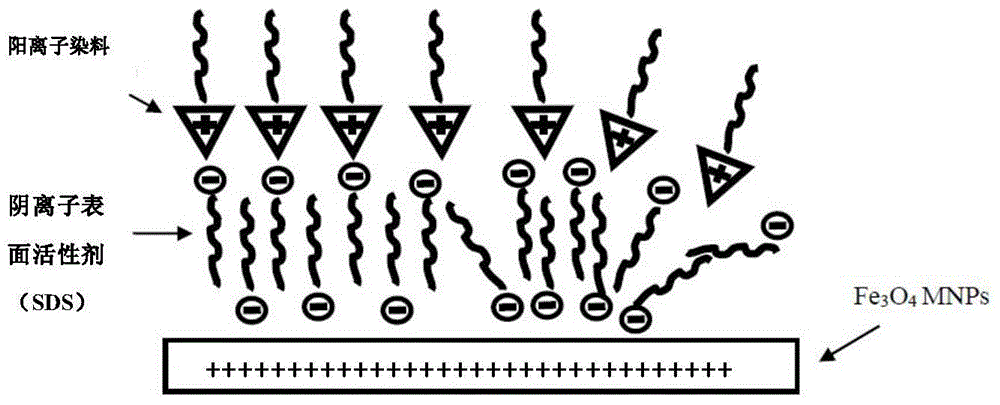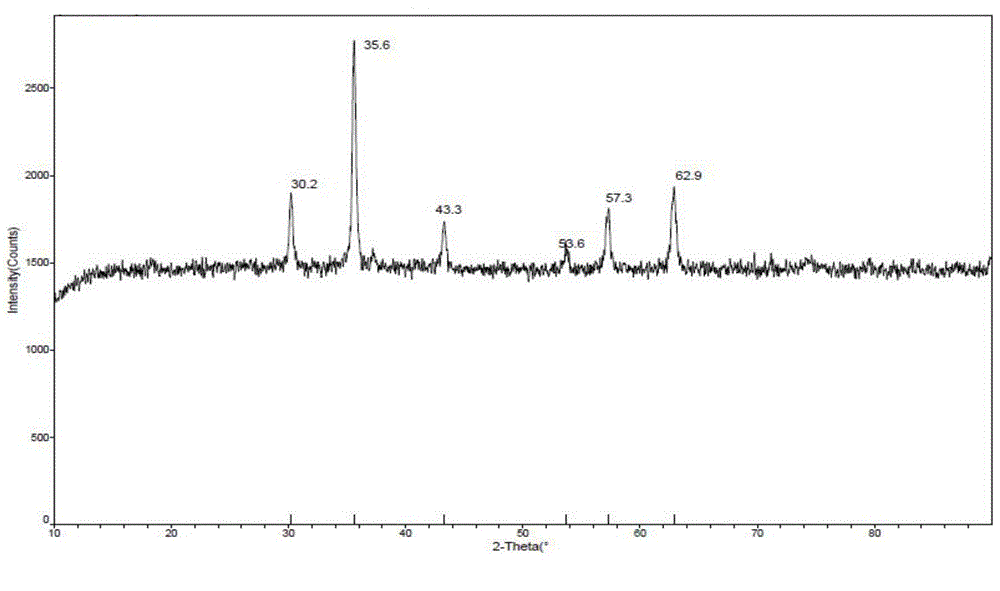Magnetic nano mixed semi micelle and preparation method thereof as well as application of magnetic nano mixed semi micelle in adsorbing and separating cationic dye from environmental water sample
A hybrid semimicelle, magnetic nanotechnology, applied in the fields of adsorption water/sewage treatment, material separation, water pollutants, etc. The effect of less, fast adsorption and low price
- Summary
- Abstract
- Description
- Claims
- Application Information
AI Technical Summary
Problems solved by technology
Method used
Image
Examples
Embodiment 1
[0036] Preparation of magnetic nano-mixed semi-micelles of the present invention
[0037] 1) Fe 3 o 4 Magnetic nanoparticles (hereinafter referred to as Fe 3 o 4 MNPs) preparation: take 2.5g solid FeCl 2 4H 2 O, 5.0 g solid FeCl 3 ·6H 2O, put it in a small beaker, add 0.9ml of concentrated hydrochloric acid and 25ml of deionized water to dissolve it completely, then transfer it to a separatory funnel; weigh 15g of solid NaOH, dissolve it in 250ml of deionized water, and transfer it to the three-hole flask, and place the three-necked flask in a 60°C water bath; under sufficient mechanical stirring, add the mixture in the separatory funnel dropwise to the three-necked flask; then, stir for 3 hours under nitrogen protection; the reaction ends Finally, a magnet was placed at the bottom of the flask, and the freshly prepared Fe 3 o 4 The magnetic nanoparticles were absorbed, the solution was poured out, washed with deionized water and ethanol until neutral, and dried in va...
Embodiment 2
[0040] Step 1) is consistent with step 1) in Example 1;
[0041] 2) Weigh the Fe prepared in step 1) 3 o 4 MNPs are ultrasonically dispersed in ionized water, the dispersion concentration is 50mg / ml, adding anionic surfactant sodium dodecylsulfonate (SDS), SDS and Fe 3 o 4 The MNPs feed ratio (w / w) was 1:1, the pH was adjusted with hydrochloric acid, vortexed and ultrasonicated to form magnetic nano-mixed semi-micelles.
Embodiment 3
[0043] Characterization of Magnetic Nanomixed Hemimicelles
[0044] 1. Fe 3 o 4 Characterization of MNPs
[0045] For the magnetic nanoparticles prepared by the method of chemical co-precipitation, use D8 ADVANCE type XRD tester (Germany Bruker company), ZEISS SIGMA HD scanning electron microscope (Germany Zeiss company), NanoZS90 type Zeta potential measuring instrument (UK Malvern company) respectively. X-ray powder diffraction (XRD) and scanning electron microscope (SEM) analyzes were carried out, and its Zeta potential at different pH values was determined.
[0046] image 3 Shows Fe 3 o 4 The SEM morphology of MNPs shows that the prepared nanoparticles are approximately spherical, relatively uniform in size, and have a diameter of less than 50nm, which has typical nanometer characteristics.
[0047] The XRD spectrum test results are as follows Figure 4 Shown: Six diffraction peaks of 2θ=30.2°, 35.6°, 43.3°, 53.6°, 57.3° and 62.9° appeared in the diffraction patt...
PUM
 Login to View More
Login to View More Abstract
Description
Claims
Application Information
 Login to View More
Login to View More - R&D Engineer
- R&D Manager
- IP Professional
- Industry Leading Data Capabilities
- Powerful AI technology
- Patent DNA Extraction
Browse by: Latest US Patents, China's latest patents, Technical Efficacy Thesaurus, Application Domain, Technology Topic, Popular Technical Reports.
© 2024 PatSnap. All rights reserved.Legal|Privacy policy|Modern Slavery Act Transparency Statement|Sitemap|About US| Contact US: help@patsnap.com










